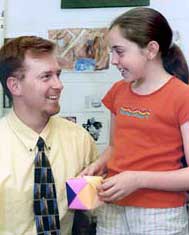 by Preston MacDougall February 12, 2005
One of the reasons that I like it so is that it reminds me of the summer of '82. No, you didn't miss a sequel to the Summer of '42. I'm talking about real life - mine. Two life-changing things happened that summer. The first was an epiphany of sorts, when through the sense of smell, it dawned on me that the organic chemistry that I had studied, and was then practicing as an undergraduate research assistant, was in fact origami at the nano-scale. If you've never taken a chemistry course, nor read Michael Creighton's thriller Prey , I probably need to give you some perspective. A nanometer is to a meter, what 150 meters is to the average distance from the Earth to the Sun. In other words, it is really, really small. Individual molecules are measured in nanometers. A single water molecule is only about one-quarter of a nanometer in length, while a single glucose molecule measures just over one nanometer, if stretched out. Cells, such as erythrocytes, or red blood cells, are typically measured in thousands of nanometers. The sizes and shapes of cells, and especially molecules, vary tremendously, with new and surprising motifs always around the corner. This expecting the unexpected is, I think, what makes science so much fun. Getting back to Aurora's cube. It is hollow, and the carefully folded pieces of brightly colored paper appear not to be fastened in any way. Yet, its shape is firm and even springs back if gently deformed. Another interesting feature is that although there are many colors woven together in the cube, none of the pieces of paper are multi-colored. The artist confirms that her medium is plainly colored sheets of wrapping paper. How is this reminiscent of organic chemistry? Back in '82, my project was to make a cage of eight carbon atoms. Not a cube, that molecule, called cubane, had already been made by clever chemists in Chicago almost twenty years earlier. The cage that I was trying to make was more like a triangular prism. The hard part was not that the cage needed to be about one nanometer in width. Rather, the hard part was that the cage had to be "finished" on its exterior with precisely 10 hydrogen atoms and two oxygen atoms. There are three ways to position the two oxygen atoms on this cage, but only one would have the sought-after symmetry. They needed to be on different sides and faces of the prism. To make it more challenging, I was expected to make these elaborately shaped little beauties starting from cheap, stock chemicals. Instead of colored paper, I had pure alcohol and toluene to work with, as well as some catalysts, such as sodium, which came out in the wash. Even my daughter's fingers are gargantuan compared to these molecular building blocks, so how to fashion the cage? This is where the century-plus of modern era chemical research comes in handy, in addition to having a supervisor well-trained in the art of organic chemistry. There are volumes on top of volumes of "Handbooks of Organic Chemistry" that contain recipes of a sort for standard construction steps when doing architecture at this scale. With these I was able to transform toluene, which gives model airplane glue its characteristic odor, into a substance that is in the family of licorice flavorings. This compound has a more complex structure than toluene, but it is still essentially flat. It was at this stage of the synthesis that the beautiful aroma came wafting from my round-bottomed flask and became nestled forever in my memory. Lastly, I had to fold the dangling parts of my work in progress into the cage structure. This is where the catalyst did its thing. At the end of the summer, I had much less than a teaspoon of my artwork, but I was not at all disappointed. The most amazing thing was that with simple chemicals, and pint-sized glassware, I had not made one perfectly shaped cage, I had made trillions and trillions of them, each one essentially the same as the other. This is why chemistry is rightly regarded as an economy-driving technology, while less known as an art. It is both. The other life-changing event from the summer of '82 was my wedding to Aurora Claire's mother. That Aurora Claire looks so much like her mother did, but has freckles like I did, is yet another miracle of chemistry. In this case, the catalyst was a high-school French class back in Canada, and the magic was chemistry of an altogether different kind. To end with a question that has been in the news of late; a molecule is a beautiful thing, but is it art?
Preston MacDougall is a chemistry professor at Middle Tennessee State University. His "Chemical Eye" commentaries are featured in the Arts and Public Affairs portion of the Nashville/Murfreesboro NPR station WMOT (www.wmot.org).
|
||
